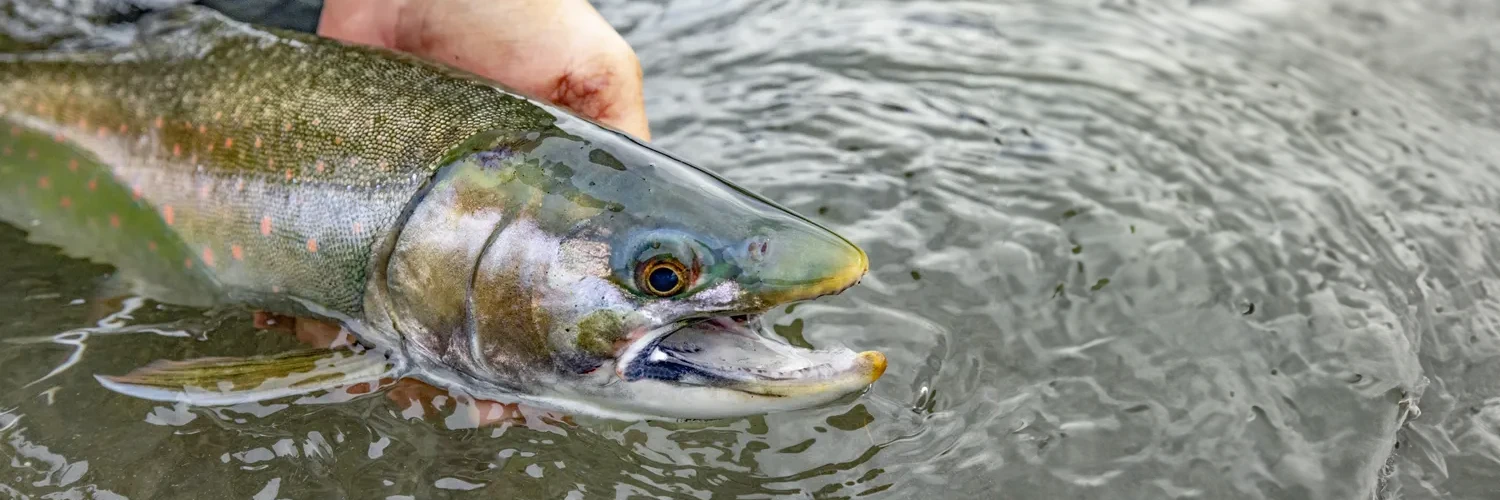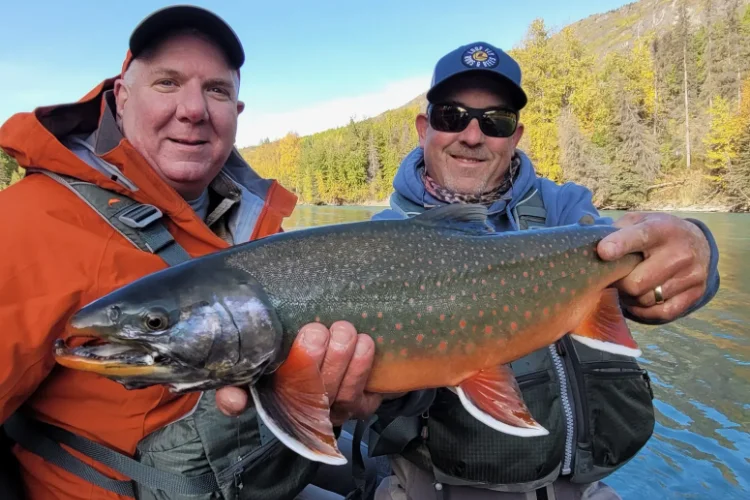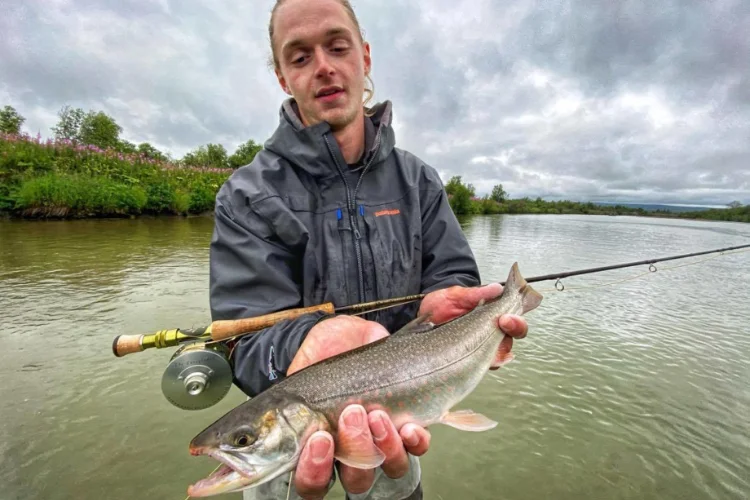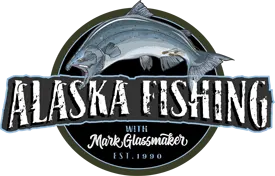
Kenai River
Dolly Varden Fishing Trips

We offer both full- and half-day fishing trips for Kenai River Dolly Varden.
Our Dolly Varden fishing trips closely resemble our Kenai River Rainbow Trout excursions, as Dolly Varden share similar feeding habits and habitat preferences. Renowned for their appetite for loose salmon spawn, these fish are prolific egg eaters.
The most effective way to catch them is by dead drifting beads. Dolly Varden fishing is essentially open year-round, but the best action aligns with the various salmon spawning periods. The fall months are by far the most productive, as dollies take full advantage of the abundant salmon eggs in the river.
Kenai Dolly Varden Fishing
The Kenai River has an abundant population of Dolly Varden, one of the most diverse and mysterious sportfish in all of Alaska. The Kenai River Dolly Varden population includes both resident species as well as the sea-run variety. Technically, Dolly Varden are not a trout but are a subspecies of Arctic Char. These popular sportfish spawn in the late fall and exhibit some of the most spectacular spawning colors on any fish in the state.
Where Are Our Dolly Varden Fishing Trips Done On The Kenai River?
Much like rainbow trout, Kenai River Dolly Varden are highly migratory and occupy different areas of the Kenai River according to where the most food is available. Early and mid-season we will cover much of the middle river in search of the best dolly varden fish and they will be feeding on out migrating salmon smolt, aquatic insects as well as left over salmon flesh from the previous season. As we enter the fall months, Kenai River Dolly Varden will congregate behind spawning salmon and feed on loose single eggs. Much of this fall feeding activity will take place in the Kenai National Wildlife Refuge below Skilak Lake.
How we fish for Dolly Varden On The Kenai River
Dolly Varden bite all the same lures, bait and flies that Kenai Rainbows do. Dead drifting single egg patterns, flesh flies, as well as swinging flies such as intruders and dolly llamas are all effective. In the spring, fishing aquatic insect patterns such as nymphs and small stone flies will yield good results.
Dolly Varden also feed heavily upon out-migrating salmon so smolt patterns in the spring should not be overlooked. During the fall months, Kenai River Dolly Varden congregate behind spawning salmon and feed on loose single eggs. Beads and other single egg patterns are top producers in the late season.
Rates for Our Kenai Dolly Varden Fishing Trips
June / July / August / September / October
Kenai Half Day – $295pp
Up to 5 hours
Kenai Full Day – $350pp
Up to 8 hours
Upper Kenai Full Day – $450pp
Up to 8 hours
Private Charter (especially recommended for fly fishing trips) – $1,000 ( 2 person max )
Up to 8 hours
Things To Know About Kenai Dolly Varden Fishing Trips:
*Spawning Season & Conditions: Dolly Varden (Salvelinus malma), a species of char, are fall spawners in Southcentral Alaska, typically reproducing in late September or October. The females create redds (gravel nests) in which they deposit between 600 and 6,000 eggs, depending on their size.
Spawning is a highly demanding process for these fish, and a significant portion of the population does not survive afterward. Studies estimate that about 70% of the males and up to 60% of the females die post-spawning. This high mortality rate is due to the energy expended during migration, courtship, and reproduction, as well as increased vulnerability to predators and environmental stress. However, those that do survive may spawn multiple times over their lifespan.
Dolly Varden exhibit both anadromous (migratory) and resident (non-migratory) life histories. Anadromous individuals travel between freshwater and saltwater, while resident populations remain in freshwater year-round.
*Hatching & Emergence: Young dolly varden emerge from the gravel in early spring months of April and May. They depend initially on their attached egg yolk before eventually transitioning to aquatic insects and small fish for their prey.
*Age, Growth, and Maturity: Most dolly Kenai River dolly varden spend 2-3 years in the freshwater before making their first journey to the ocean. When transitioning to their ocean environment, dolly varden loose their par marks and become more silver in appearance. Some Kenai River dolly varden do not migrate to salt water but rather over winter in both Kenai and Skilak Lakes. With a lifespan of up to ten years, Kenai dollies spend the majority of their adult lives in a mysterious migration between fresh and saltwater environments as they follow various abundant food sources.
Kenai River Dolly Varden Limits
The limit for Alaska fishing trips for dolly varden on the Kenai River is one fish per day under 16 inches. The majority of Kenai River anglers targeting dolly varden practice catch and release as dollies are primarily resident species and do not all die each season like salmon. The health of their overall population and their ability to reach trophy sizes depends on responsible catch and release practices.

FAQ’s About Dolly Varden Fishing
Where to catch Dolly Varden in Alaska?
What is the best bait for Dolly Varden?
What is the limit on Dolly Varden in Alaska?
Is Dolly Varden good to eat?
More Information on Kasilof River Trout Fishing
After several years of falling short of minimum escapement objectives, the 2025 late run of Kenai River king salmon narrowly met the recovery threshold of 14,250 large kings (greater than 34 inches). By the final day of counting, the cumulative sonar estimate stood at 15,015 fish. This benchmark was established under the Kenai River Late …
The 2025 silver salmon run on the Kenai River has been noticeably stronger than in 2024. Last year, anglers faced bait closures and reduced limits, but this season brought a robust return that provided excellent fishing opportunities. Key highlights: Bait opened Aug. 16, right as fishing pressure shifted from sockeye to silvers, with fresh coho …
The summer of 2025 produced the largest return of sockeye salmon to the Kenai River since modern sonar counting began in 1987. By August 19, a staggering 4,252,497 sockeye had passed the Alaska Department of Fish & Game sonar station at river mile 19. The surge began on July 16 with a daily count of …
Kenai River Sockeye Fishing: 468,000 fish in three days! With the 2024 fishing season officially behind us, it’s finally time to look back and recap another blockbuster season for us at Alaska Fishing. Cindy and I are profoundly grateful for all the amazing customers, both new and old, and also for our incredible help as …
Summary of actions at the 2024 Upper Cook Inlet Board of Fisheries Meeting as it pertains to the sportfishing angler visiting the Kenai Peninsula for the next three seasons. The most significant action taken at Upper Cook Inlet Finfish Meeting: Feb 23-March 5, 2024 is in response to the stock of concern status for Kenai …
After a very mild winter and another hot and dry spring here on the Kenai Peninsula, we experienced a very large fire that began in early June and continued well in August and early September. The fire began on June 5, 2019 and was caused by lightning in a remote area of the Kenai National …

